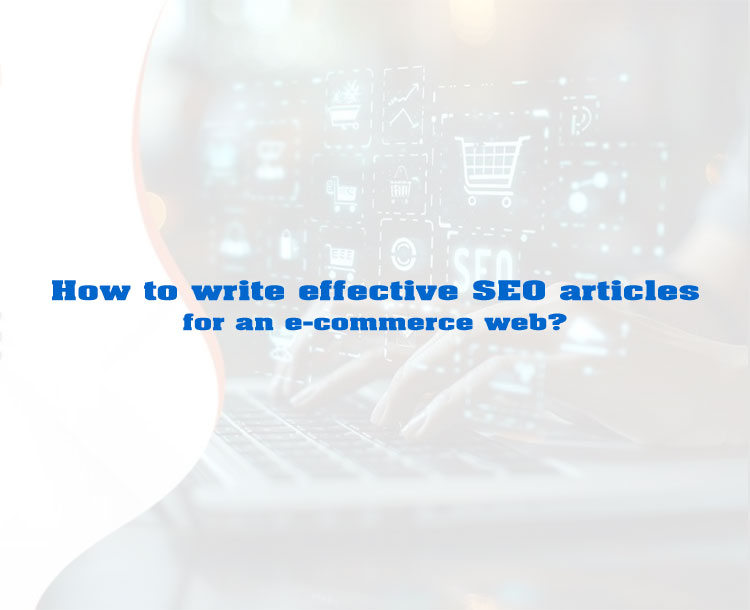How to write SEO content for an e-commerce sales website?
- Understanding SEO Articles for E-Commerce Websites
- Challenges of Writing SEO for Low-Content Websites
- SEO Writing Strategies for Content-Light E-Commerce Sites
- Ideal SEO Article Structure for Product-Based Websites
- 1. Attention-grabbing title with keyword
- 2. Introduction
- 3. Clear subheadings (H2, H3) with related keywords
- 4. Conclusion
- Keywords: The Core of Effective SEO Writing
- Diversify Your Content Formats to Boost SEO
- 1. Product usage guides
- 2. Product comparisons
- 3. Shopping tips and advice
- 4. Frequently Asked Questions (FAQs)
- Technical SEO Tips for Your Content - Experience from Viet SEO agency
- Maintaining and Scaling Content Over Time
- Conclusion
So, how can you write effective SEO content for a sales website with limited content? This guide will walk you through how to create SEO-optimized articles for e-commerce websites—even if you're short on information or lack diverse reference materials. Whether you're a business owner or an SEO content writer, these tips will help you turn minimal content into maximum impact.
Understanding SEO Articles for E-Commerce Websites
Many e-commerce websites focus heavily on products but overlook the power of SEO-driven content. Viet SEO agency emphasizes that well-crafted SEO articles not only boost visibility on Google but also help build trust, guide purchasing decisions, and improve overall site performance.
1. What is an SEO article?
An SEO article is content that’s optimized to rank higher for targeted keywords on search engines like Google. The goal is to make your content more discoverable by potential customers, ultimately driving conversions and increasing revenue.
2. Why do e-commerce websites need SEO content?
- Increase free organic traffic
- Improve brand visibility
- Boost conversion rates from readers to customers
- Save on long-term advertising costs
Challenges of Writing SEO for Low-Content Websites
Writing SEO content for websites with limited information can be a real challenge, especially for e-commerce platforms focused solely on product listings. Viet SEO company understands these limitations and provides tailored strategies to help businesses enhance visibility and rankings—even with minimal on-site content.
1. Limited product information
Some industries or small businesses only have basic product descriptions, with no detailed documentation from manufacturers.
2. Difficult to stand out
Without unique content, your website might end up duplicating content from others—risking lower rankings on Google due to lack of originality.
3. No blog or content hub
Many e-commerce sites only focus on product pages and neglect having a blog—missing out on valuable opportunities to create SEO-driven content.
SEO Writing Strategies for Content-Light E-Commerce Sites
Content-light e-commerce sites often struggle with SEO due to limited text and supporting information. VietSEO recommends smart strategies like optimizing product descriptions, leveraging FAQs, and creating category-level content to boost visibility and drive organic traffic—even with minimal content.
1. Focus on user insight
Not much info to start with? No problem. Begin by researching your actual customers:
- What are they searching for?
- What do they want to know before buying?
- What questions do they frequently ask?
Based on these, you can create articles such as:
- How-to guides
- Buying guides
- Product comparisons
- FAQs
2. Analyze competitors
Even if you lack content, your competitors probably don’t. Look up relevant keywords, visit the top-ranking pages on Google, and analyze:
- What are they writing about?
- How long is their content?
- What keywords are they targeting?
From there, rewrite and repurpose the information in your own unique voice—ensuring originality and added value.
3. Leverage customer feedback and reviews
User reviews from e-commerce platforms, social media, or your own website are goldmines for content ideas:
- Real-life experiences
- Benefits of the product
- Common issues
Use these to write product reviews, pros and cons lists, or troubleshooting guides.
Ideal SEO Article Structure for Product-Based Websites
Creating the right article structure is essential for product-based websites aiming to rank higher on search engines. Viet SEO recommends a clear, user-friendly layout that includes keyword-rich headings, compelling introductions, detailed product benefits, FAQs, and strong calls-to-action to boost both SEO and conversions.
Even with limited references, you can still create a well-structured, Google-friendly article:
1. Attention-grabbing title with keyword
Example: “How to Choose the Best Juicer for Your Family in 2025”
2. Introduction
Summarize the problem, need, or benefit.
Example:
“Looking for a juicer but unsure which one is right for your family? This article will help you make an informed decision.”
3. Clear subheadings (H2, H3) with related keywords
Example:
- H2: Why Choose a Slow Juicer Over a Fast One?
- H3: Durability of Slow Juicers
4. Conclusion
Recap the content and include a clear call-to-action (CTA), such as:
- Buy now
- Leave a comment
- Contact for consultation
Keywords: The Core of Effective SEO Writing
Keywords are the foundation of every successful SEO strategy. VietSEO agency emphasizes the importance of selecting the right keywords to align with user intent, boost visibility, and drive qualified traffic. Using keywords strategically—not just frequently—can make all the difference in how well your content performs.
1. Choose long-tail keywords
Short keywords are often too competitive. Try more specific ones like:
- “best slow juicer for elderly people”
- “should I buy an air purifier for a small bedroom?”
2. Place keywords strategically, not excessively
Include the main keyword in:
- The title
- H1 and H2 tags
- The beginning and end of the article
- A few natural mentions throughout the body
Diversify Your Content Formats to Boost SEO
Relying on a single type of content limits your website's SEO potential. Viet SEO company recommends diversifying content formats - such as blog posts, product guides, FAQs, videos, and customer reviews - to target more keywords, enhance user experience, and improve overall search rankings.
Even without tons of reference material, you can still create a range of SEO-friendly content:
1. Product usage guides
Example: “How to Install a Karofi Water Purifier at Home Easily”
2. Product comparisons
Example: “Xiaomi vs. Ecovacs Robot Vacuums – Which Is the Better Choice?”
3. Shopping tips and advice
Example: “5 Things to Keep in Mind When Buying a Dishwasher Online”
4. Frequently Asked Questions (FAQs)
Compile common customer questions into in-depth FAQ articles.
Technical SEO Tips for Your Content - Experience from Viet SEO agency
Great content needs strong technical SEO to perform well on search engines. VietSEO shares essential tips like optimizing heading tags, improving page speed, using clean URLs, and implementing schema markup to ensure your content is both user-friendly and search-engine ready.
1. Meta title and meta description
- Include the main keyword
- Keep meta title: 55–60 characters
- Keep meta description: 150–160 characters
2. Image optimization
- Name image files with relevant keywords
- Add accurate and descriptive alt text
3. Use internal and external links
- Link to related product pages
- Link to other helpful articles on your site
- Link to reputable external sources (when relevant)
Maintaining and Scaling Content Over Time
Creating great content is just the beginning; maintaining and scaling it over time is key to long-term SEO success. Viet SEO services recommends regularly updating articles, expanding related topics, and optimizing internal links to keep your content fresh, relevant, and highly visible on Google.
1. Create a regular content calendar
Aim to publish 4–8 articles per month to keep your website fresh and active.
2. Update old articles
Revise older content to include new information or improve clarity—helping them rank higher over time.
3. Integrate AI and SEO tools
Use tools like ChatGPT, Google Keyword Planner, Ahrefs, and more to generate content ideas and streamline optimization.
Conclusion
Writing SEO content for e-commerce websites with limited reference material isn’t easy—but it’s far from impossible. By understanding your customers, leveraging real user experiences, and building smart, keyword-rich content structures, you can create valuable content that ranks well and drives long-term growth.
Start simple: research long-tail keywords, listen to your audience, and optimize each piece of content thoroughly. SEO success doesn't happen overnight—but with the right strategy and persistence, it will come.



